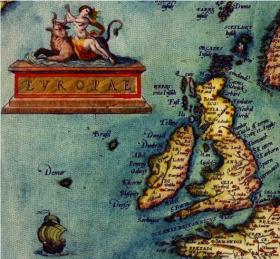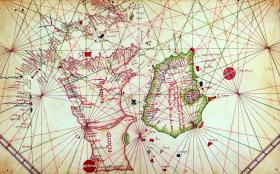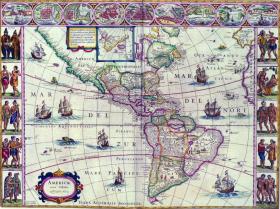An island called Brazil
Published in 18th–19th - Century History, Early Modern History (1500–1700), Features, Issue 4 (Jul/Aug 2008), Medieval History (pre-1500), Pre-history / Archaeology, Pre-Norman History, Volume 16
Detail of a map of Europe from Theatrum Orbis Terrarum by Abraham Ortelius (1570), showing the island of ‘Brasil’ off the west coast of Ireland. (British Library)
What is the origin of the word ‘brasil’? In my homeland, Brazil, it seems that everyone knows the answer. Following the definition of the German naturalist Alexander von Humboldt, it comes from brasa and is associated with the reddish colour of brazilwood (pau-brasil in Portuguese), a dyewood tree commonly found along the Atlantic coast of South America at the time of its European discovery in the sixteenth century. But the Houaiss Dictionary, considered the most comprehensive of the Portuguese language, tells us (2001 edition) that the ‘etymon of this toponym’ (i.e. the word from which this place-name is derived) has been the subject of the most varied hypotheses. It lists no less than sixteen possible explanations for the origin of brasil—the word, not the country name. Among them one stands out: brasil could have its origin in the Irish language, more precisely in Hy-Brazail or Hy Brasil, an ancient island of the Atlantic Ocean.
According to Barry Cunliffe, Professor of European Archaeology at Oxford University, Hy Brasil is the most intriguing of all the legendary islands of the Atlantic, said to lie not far off the west coast of Ireland, and so named and placed on charts from the fourteenth century:
‘The legend goes back much further, probably into pre-Christian times, appearing first in the seventh century in the Irish text known as “The Adventure of Bran Son of Febal”, which tells of Bran’s visit to this Other World island supported on pillars of gold where games are played, people are always happy, there is no sorrow or sickness, and music is always to be heard—truly a land of the blessed.’
This is the basis for the argument that the name of the country Brazil is Irish in origin and not from the well-established brazilwood version. But the story of Hy Brasil is not well known among Brazilians and it is certainly not what we were taught in school.
In the past, the legendary island generated heated debates among Brazilian historians. In O Brasil na lenda e na cartografia antiga (1941), Gustavo Barroso, first director of Brazil’s National Historical Museum, believed in a parallel development of the two concepts—the legend of Hy Brasil and the dyewood tree—until ‘Brasil Island’ and ‘brazilwood’ were merged together in a definite geographical term. After explaining and documenting the two separate roots, Barroso stated that we were entitled to ask ourselves: ‘What do Brazilians prefer: that the name of their own nation signify Blessed Land, Fortunate Land, Land of the Blest, or refer solely to an ordinary and utilitarian commerce of a dye wood?’

Map of Britain and Ireland by Grazioso Benincasa, Venice, produced in 1473 before the convention of placing north at the top was adopted. The Isola di Bracil (Island of Brasil) is represented as a large red circle off the coast of Ireland—27 years before the discovery of Brazil by the Portugese. (British Library)
Although very attractive, this alternative view is not accepted in Brazilian academic circles. According to Professor José Murilo de Carvalho, a leading Brazilian historian and current member of the Brazilian Academy of Letters and the Brazilian Academy of Sciences, none of the contemporary authors of the Portuguese arrival mentions the Brazil Island as a possible inspiration for the baptism of the new land:
‘All of them are unanimous in attributing the name Brasil to the dyewood found in the new land. And also, despite the hypothesis raised, it was not possible to demonstrate any association between Brazil Island and brazilwood.’
Presence in maps
If, on the one hand, there is no historical document linking the island to the country’s name, on the other there is plenty of evidence to establish a remarkable and intriguing cartographical existence. The first known appearance of the Island of Brasil on a map was in 1325 and the last one was probably in 1870—545 years of mystery. Why did it take so long for an island that apparently never really existed to disappear from maps? One detail pointed out by researchers is that the Island of Brasil was depicted for a long time at the same coordinates. Although it appeared in some nautical charts among the Canary Islands, Azores, Madeira and even on the coast of Canada, the island was mostly faithful to its position to the west of Ireland.
The book Antique maps by Carl Moreland and David Bannister gives a brief account of the island’s presence in maps and sums up its impressive cartographical life:
‘It is hard to believe that as late as the eighteenth century seamen were still seeking these islands, and so often had Brazil been “sighted” that geographers were reluctant to abandon the possibility of its existence; in fact it was not finally removed from British Admiralty charts until the 1870s’.
Era of discovery
Once anchored in maps, mythical islands like Hy Brasil were no longer the uncertain target of trivial adventure and became the destination of more experienced explorers. In case it really existed, the island would be strategically positioned on the route to lands beyond the sea and could be used as a stop-over for resting and for collecting fresh water during long journeys. It could also be seen as a land in its own right to be conquered and colonised. Therefore Hy Brasil entered the era of discovery.
According to Fridtjof Nansen in Northern mists, a great ship belonging to John Jay Jr set off from Bristol towards the insulam de Brasylie in 1480. After two months at sea, they returned to Bristol without finding Hy Brasil. In the following year, two other ships, Trinity and George, left England in search of the Island of Brazil, but also returned unsuccessfully.
But out of these attempts arose a great achievement. Taking his ship even further west, the navigator John Cabot or Giovanni Caboto, probably from Genoa, officially discovered in 1497 the island of Newfoundland, on behalf of the English crown, establishing the first step for the British settlement of Canada. Inspired by Columbus, Cabot’s main objective was to discover a short cut to the Indies, but he also expected to find Hy Brasil on his way.
On 25 July 1498 the Spanish envoy in London, Pedro de Ayala, wrote to the Catholic monarchs of Spain, Ferdinand and Isabella, reporting the British effort in searching for Hy Brasil or the island of Brasil:
‘For the last seven years the people of Bristol have equipped two, three [and] four caravels to go in search of the island of Brazil and the Seven Cities according to the fancy of this Genoese. The king made up his mind to send thither, because last year sure proof was brought they had found land.’
The Portuguese, fishing for cod near the Canadian coast, also claimed the discovery of Newfoundland. It is quite interesting to observe the similarity of the facts and the closeness of the dates. While Pedro Álvares Cabral prepared his caravels that would lead him to the discovery of Brazil in 1500, Portuguese seamen were navigating in a sea full of fish on the same route to that of the mythical Hy Brasil. We have every reason to believe that the Portuguese were aware of the stories of the Island of Brazil; the Spanish royalty of the time were certainly aware of ‘Hy Brasil’, as we see from de Ayala’s report, prior to the Portuguese discovery of ‘Brazil’ only two years later. Could we find here any fundamental connection to the naming of the country?
The idea that the name ‘Brasil’ was in the air at the same time as the discovery of Brazil could lend some weight to the theory that the naming was influenced by the belief in the island, were it not for the fact that on its discovery in 1500 Brazil, as we know the country today, was not originally given that name at all. Who, in the end, gave the name Brazil to what is today the largest country in South America? Certainly it was not Cabral, who called it Terra de Vera Cruz (Land of the True Cross). The Portuguese king, Dom Manuel I, changed it to Terra de Santa Cruz (Land of the Holy Cross). The popular name ‘land of brazil’ was adopted by those who crossed the Atlantic back and forth with their ships loaded with brazilwood, the first product to be extracted commercially from the newly discovered Portuguese colony. It is almost certain that the first official documented appearance of the name ‘Brazil’ as the name of the country was in 1530, a full 30 years after its discovery.

Map of North and South America produced by Jean Blaeu in Amsterdam in 1663, showing both Brazil the country and ‘Brasil’ the island (the blue dot in the North Atlantic). (British Library)
Art and literature
Leaving the debate about the country’s name aside, the fascinating history of the island stands on its own. The legend of Hy Brasil had such a strong presence in the oral tradition and folklore of Ireland that many artistic manifestations tried to reproduce this environment of beauty and happiness. Poets, musicians, painters and writers used their creativity to reconstruct, in one way or another, what could not be reached in a real world. Art became the best portal to get to Hy Brasil.
Among all forms of representation of the legend of this island, it was in literature that Hy Brasil found its true expression. There are many references to the island in poems, novels and old manuscripts, including works by famous Irish writers. W. B. Yeats, for example, reproduced Gerald Griffin’s poem Hy Brasil, the Isle of the Blest (probably the most famous poem on Hy Brasil) in his book Fairy and folk tales of the Irish peasantry (1888):
‘On the ocean that hollows the rocks where ye dwell,
A shadowy land has appear’d, as they tell;
Men thought it a region of sunshine and rest,
And they call’d it “O Brazil—the Isle of the Blest”.
From year unto year, on the ocean’s blue rim,
The beautiful spectre show’d lovely and dim;
The golden clouds curtain’d the deep where it lay,
And look’d like an Eden, away, far away.’
But none of the stories about Hy Brasil had the impact of a wonderful book that became a bestseller in 1675 in England. O’Brazile, or the Inchanted Island: being a perfect relation of the late discovery, and wonderful dis-inchantement of an island on the north of Ireland, is the publication of what pretended to be a real letter reporting the final discovery and disenchantment of the island of O’Brazile. It describes how a group of people found the island after a thick fog and how they broke its spell by lighting a fire. According to Professor Isabel M. Westcott, from the University of Swansea, the book of O’Brazile is another brilliant fiction carefully constructed by the writer Richard Head, marking a change in the literary style of the time. Another work attributed to Richard Head is The western wonder or O’Brazeel, an inchanted island discovered (London, 1674), which presents different accounts of the appearance and disappearance of this mysterious island.
The story of Hy Brasil was also used to reinforce Christian doctrine. This can be found in an extremely rare text: Voyage to O’Brazeel, or the submarine island—giving a brief description of the country and a short account of the customs, manners, government, law and religion of the inhabitants. The manuscript, written between 1558 and 1603, is the description of a fantastic journey to O’Brazeel, a submarine island that sank off the coast of Ireland. Below the waters, enclosed in a type of huge bubble, there was a small country, a land of virtue and Christian faith—and happy people.
Another incredible reference is a fascinating medical manuscript that became known as The Book of the O’Lees or the Book of the Island of O’Brasil, probably from the fifteenth century and kept today among the rare documents of the Royal Irish Academy in Dublin. Written in Irish and Latin, the book is apparently a translation of old medical treatises and lists the cure and treatment for several diseases. But the amusing fact about this book is that it was used in the seventeenth century by a certain Morogh O’Ley, who claimed that he was taken mysteriously in 1668 to the Island of Brasil, where he received the book and the recommendation not to open it until seven years had passed. After this period he opened the book and realised his ability to treat all sorts of human illnesses, although he never had any training to do so, and everything was attributed to his ‘journey’ to Hy Brasil. For some Irish historians, Morogh O’Ley probably inherited the book from his family and after some professional misfortunes started to use it as a way of making a living.
Hy Brasil lives on
An extremely interesting aspect of this entangled story is the presence of the name Brasil in proper names, place-names and family names in Ireland. In the telephone directory for Tralee, Co. Kerry, I found different variations of this surname that would leave any Brazilian very intrigued: Brassil, Brassill, Brazier, Brazil, Brazill, Brazzill. Even more interesting is to see those names on the front of shops, such as a small grocery called Brassils Stores in Tralee, or Brassil’s Guest House in Ballyheigue. According to the book More Irish families by Edward Mac Lysaght, Brassil or Brazil, or even O Brazil, are Anglicised versions of the Irish surname Ó Breasail, mainly found in counties Waterford and Offaly. The name O’Brasil, according to Mac Lysaght, already existed in 1308, and the name O Bressyl is even older, being recorded in 1285 in County Cork. This leaves no doubt of an Irish history for the name Brasil, totally independent of the South American country.
In summary, we can see Hy Brasil in at least three ways: physical, symbolic and historical. The first one refers to an optical effect that projects an illusionary image of an island along the coast of Ireland. It is a kind of mirage generated by the reflection of solar light. The second way to see Hy Brasil is through its mystical, mysterious and spiritual side. The island symbolised a land of eternal youth, an earthly paradise, an idealised world full of pleasure, eternal life and peace in the comfort of gods. It was a world that everyone would wish to live in now, or possibly to go to after this life. Finally, Hy Brasil can be associated with the history of European maritime expansion. This island could provide evidence, or at least a very strong suspicion, of knowledge of lands on the other side of the Atlantic, long before they were officially discovered.
Geraldo Cantarino is a Brazilian journalist, writer, translator and author of Uma ilha chamada Brasil (Rio de Janeiro, 2004).
Further reading:
B. Cunliffe, Facing the ocean: the Atlantic and its peoples (Oxford, 2001).
D. S. Johnson, Phantom islands of the Atlantic: the legends of seven lands that never were (London, 1997).
D. Ó hÓgáin, ‘The Mystical Island in Irish folklore’, in Islanders and water-dwellers: proceedings of the Celtic–Nordic–Baltic Folklore Symposium, UCD, 16–19 June 1996 (Dublin, 1999).
T. J. Westropp, ‘Brasil and the legendary islands of the North Atlantic: their history and fable. A contribution to the “Atlantis” problem’, Proceedings of the Royal Irish Academy 30 (Dublin, 1912–13).
















